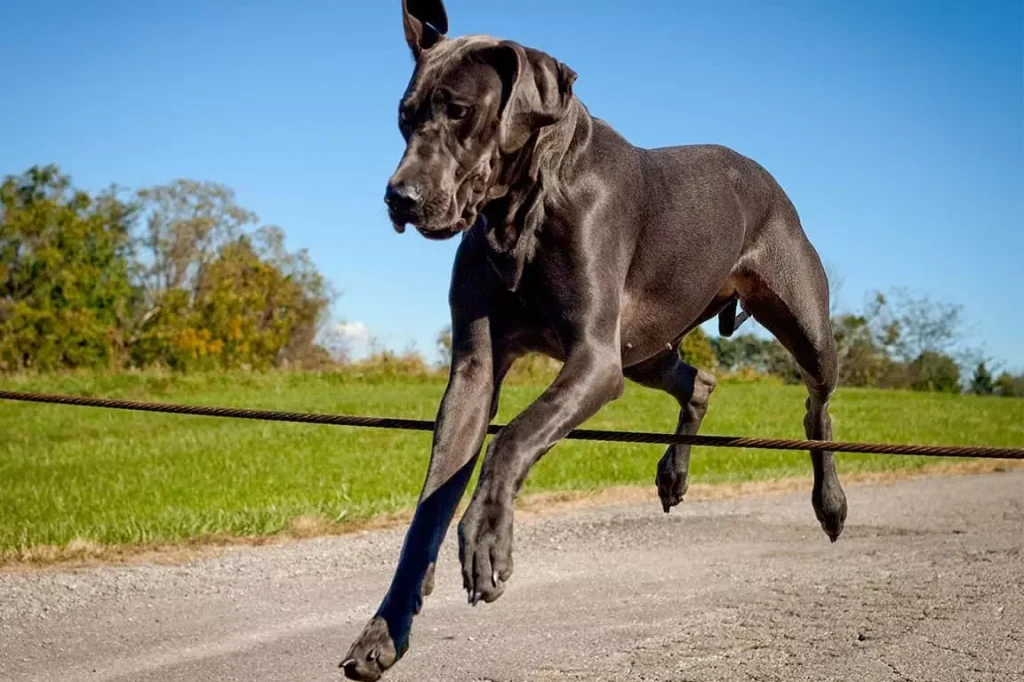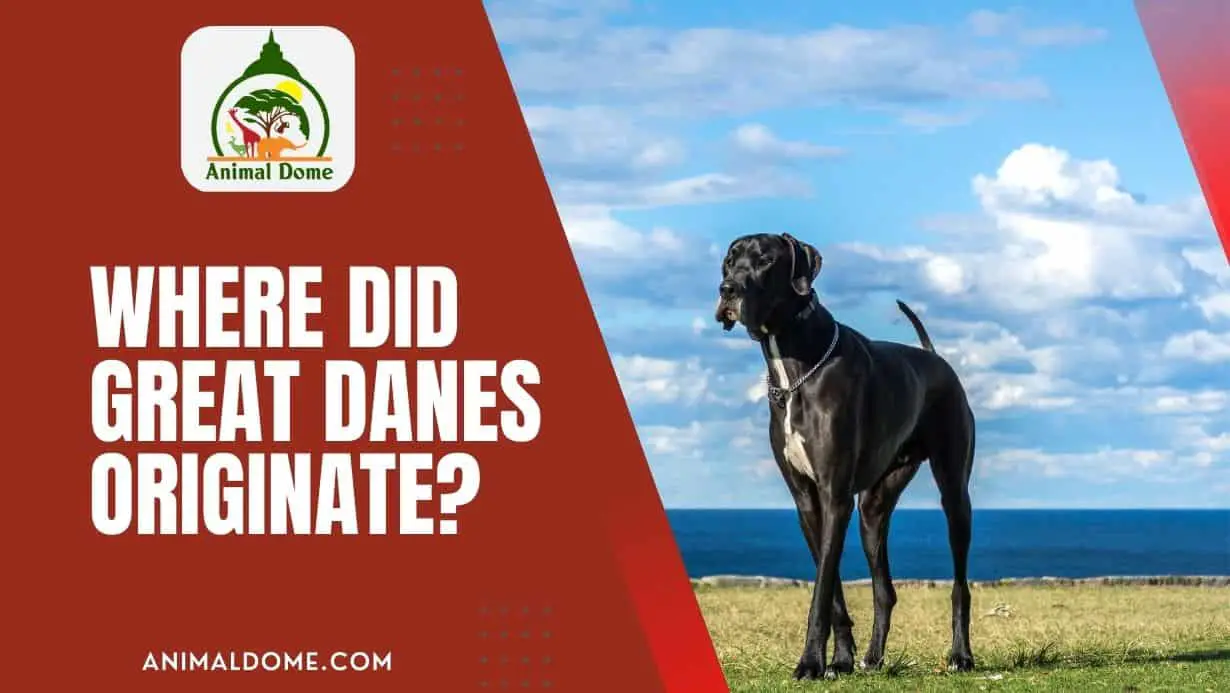Great Danes are known as gentle giants and easily recognizable dog breeds. Great Danes originate in Germany and are the giant dog breed globally. These are working dogs due to their tall structure, long limbs, short fur, muzzles, large heads, and narrow bodies. Danes have incredible companionable personalities.

Great Danes represent the giant dog category, dominating medium breeds. They have an intelligent and calm temperament, make amazing family pets, and can’t live without their owners. If a Great Dane is well-trained, it can grow in most families. You don’t need an extra-large home to adjust to Dane’s size, but extra space is necessary for the long tail.
Sadly, Great Danes have a shorter lifespan than other canines. However, spending time with sweet dogs like Great Danes is worthwhile. Here find out more about these wonderful companions.
Great Danes Overview
| Origin | Germany |
| Breed Group | Working |
| Coat | Short, Flat, Smooth |
| Height | 28-32 inches (Females), 30-34 inches (Males) |
| Weight | 99-130 pounds (Females), 120-200 pounds (Males) |
| Temperament | Calm, Friendly, even-tempered, proud, joyful, gentle, loving, and attentive |
| Coat color | Black, blue, fawn, merle, solid white, black & white, brindle, harlequin, silver, and mantle |
| Hypoallergenic | No |
| Lifespan | 6-8 years |
| Other Names | Dane, German boarhound, German Mastiff, Grand Danois |
History and Origin
Great Dane is a giant breed known as the “Apollo of dogs.” Great Danes originated in German, not Danish. This breed has been there for more than 400 years. Great Dane’s ancestors were Mastiff, used for hunting wild boar and protecting the countries. Danes were reputable guardians of carriages and states in the 18th century.
They were also famous for dog sports. During the 1800s, the Great Danes evolved more into what we know today. Germany prohibited the name “Great Dane” in 1880 and named this breed “Deutsche Dogge”, which means German Mastiff. However, the Great Dane’s name still continues in English-speaking countries.
Despite their size, Great Danes are great family pets. Also, some owners keep them to guard against robbery. Also, in 1887, Great Danes were officially recognized by AKC (American Kennel Club).
Great Danes Characteristics

Great Dane is a noble breed that makes a magnificent first impression. However, these dogs are cute once you know them.
Appearance
Size is the most prominent feature of this breed. Generally, a male Great Dane is 34″ tall at the shoulder and weighs almost 140-170 pounds. Also, large Great Danes can weigh more than 200 pounds. While female Great Danes are smaller than males. Regardless of gender, larger animals are more prized.
Great Dane’s coat colors include black, blue, harlequin, fawn, mantle, and brindle. Several theories exist regarding the Great Dane’s ears. Naturally, Dane’s ears are hanging down and large. In the US, the ears are typically cropped and tapped to support them to stand upright.
Training
As Great Danes are big, they must get obedience training in puppyhood. This breed is not for jumping on you or sitting in your lap. They must be educated to remain on the ground and to interact with children. Otherwise, who might be beaten by their sheer size. Training is a must for every Dane, no matter how friendly they might be.
Temperament
Great Danes are wonderful companions. Generally, these are calm and are good with children. Danes are human lovers and enjoy human companionship instead of kennel life. You can imagine a Great Dane very loving and loyal to all family members.
In addition to their physical care, giving your Great Dane a name that reflects their noble stature and unique personality is crucial. While selecting the perfect name for your canine companion, consider their traits, the stories behind their breed, and how they resonate with your family’s dynamics.
But these dogs are silent with strangers until they become familiarized. Due to their large size and deep bark, Danes are often considered watchdogs.
Grooming
Great Danes typically have short, thick coats that do not require tough grooming. They need basic grooming with infrequent brushing. These dogs shed mostly in fall and spring, so they must bathe routinely twice a month. Danes must have routine ear cleaning and checkups.
While some owners crop Dane’s ear, which is not a healthy practice and has been prohibited in some countries. You must trim your Dane’s nails every two weeks to prevent weak feet, nail tearing and keep them healthy. Also, brush your Dane’s teeth frequently to maintain good dental hygiene and prevent gun disease. So, grooming is a must for Danes.
Exercise
Great Danes are very energetic and playful pooches. Do not let them jump and run until 18 months old to keep their bones and joints healthy. Danes have moderate energy levels according to their age. So, routine exercise, for instance, daily walks, is useful for your dog to keep it healthy and fit. Also, the Danes play safely in fenced yards.
Lifespan
Their extremely large size can put an enormous strain on their hearts. An average Great Dane’s life span is almost 7 years. However, some Danes live longer with perfect care.
Common Health Problems of Great Danes
Great Danes can suffer health problems due to their sheer size. Here are the health issues:
- Bloat (GDV): Bloat (Gastric Dilatation Volvulus) is also known as gastric torsion, in which Dane’s stomach twists and is filled with gas. It is a deadly disease, so in this situation, consult the veterinarian immediately.
- Bone Cancer: Great Danes, also called osteosarcoma, are sensitive to bone cancer.
- Cardiomyopathy is a heart disease in which the heart becomes enlarged and leads to heart failure in Great Danes if not properly treated.
- Hip Dysplasia: It is common in giant breeds and is caused by a malformation in hip joints due to aging.
- Wobbler Syndrome: This condition is also known as Cervical Vertebral Instability or Cervical Spondylomyelopathy. It is caused by the contraction of the spine in Great Dane’s neck and affects neurological abilities.
- Hypothyroidism is a low thyroid disease that prevents the glands from producing enough hormones to control the metabolism well.
- Elbow Hygroma: Your Great Danes may develop a fluid-filled growth on the elbow. Typically, Elbow Hygroma is caused when your pup lies on hard surfaces frequently.
Great Danes Nutrition & Diet
It is essential to feed your Great Dane puppies large breed food to prevent fast growth (that lead to hip dysplasia and bone diseases). The veterinarian will suggest feeding your Great Danes meals in portions daily instead of large meals to prevent bloat. You can also utilize a Slow Feeder or Elevated food Bowls for Danes.
Adult Great Danes need more food than puppies, such as 10 cups daily. Also, do not overfeed your Great Dane, as it can lead to obesity. Ask your veterinarian to regulate the appropriate diet according to your Dane’s activity level, weight, and age.
Buying or Adopting a Great Dane
If you have decided to adopt a Great Dane, check in your area for breed-specific rescues. Sadly, many dogs need a new home because the owners do not find them their match. If you plan to adopt a puppy, go for a responsible breeder to ensure your Dane comes from a bloodline breed for healthy genetics and temperament. Typically, Great Dane puppies cost almost $1000-$2000, but prices can be high, up to $7000, depending on pedigree. You can also choose your Great Danes from the Great Dane Club of America, AKC Great Dane Breeders, and Mid-Atlantic Great Dane Rescue League
Great Danes Advantages & Disadvantages
| Advantages | Disadvantages |
| Go along with other pets | It costs more to Feed Danes |
| Incredibly loving and gentle giant | Danes have a short lifespan |
| They are good Guard Dogs | Prone to Getting Bloat |
| Danes are easy to Groom | Needs Strength to Handle on leash |
| Great with children | Prone to slobbering |
FREQUENTLY ASKED QUESTIONS
Are Great Danes Aggressive?
Typically, these are not aggressive. Great Danes have a calm temperament in their bloodline. Also, they are great with other pets and children when trained properly.
How did the Great Danes get so big?
Great Danes got their enormous size from their ancestors. It is a crossbreed of the Irish wolfhound, and Mastiff both are giant dog breeds. Danes were bred to hunt boars.
Are Great Danes easy to train?
Sometimes Danes can be stubborn with thorough training, but overall these are trainable. Obedience classes are a great way to teach good behavior to your Great Dane puppy.
Is Great Dane German or Danish?
Great Danes originated in German, not Danish. This breed appeared more than 400 years ago. Dane’s ancestors were English Mastiff-like dogs and were used for boar hunting in ancient times.
Are Great Danes good Family dogs?
If trained obedience in puppyhood, Great Danes make wonderful family pets. These dogs are known for their friendly, calm, and gentle nature.
Do Great Danes bark a lot?
Generally, Danes do not bark a lot. They only bark to alert their owners when they see some stranger in-home or backyard. So, this breed does not develop loud habits if trained to discourage barking in puppyhood.
When did the Great Danes originate?
This dog breed appeared in Egyptian carving 400 years back, but modern Danes were bred in Germany in the 1800s for boar hunting.
Wrapping Up
The beauty and temperament of Great Danes make them incredibly attractive pets but buying them on a whim is not a good idea. It is essential to make a well-informed decision when adopting a Great Dane.
Research the breed and seek breeders who know the health problems associated with these Danes. And also they work to eliminate health issues from their breeding program. Investing in a Dane will require a significant financial outlay, so it’s worth researching before getting one. Hopefully, this guide helps you a lot. Please share it with your friends. Thanks for reading!





